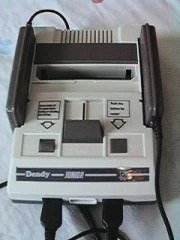 The Dendy Jr. model | |
| Manufacturer | Steepler |
| Type | Console |
| Release Date | 1992 |
| Discontinued | 1996 |
| Media | cartridges |
The Dendy is a Nintendo Entertainment System (NES) clone produced by Steepler for Russia and China. Since no officially licensed version of the NES was ever released in the former USSR, the Dendy was easily the most popular video game console of its time in that region, and enjoyed a degree of fame roughly equivalent to that experienced by the NES/Famicom in North America and Japan.
History[]
The Dendy first appeared on the market in late 1992, selling at the price of 39000 rubles ($94). The console had its own animated Russian television commercial with the phrase "Dendy, Dendy! We love Dendy! Dendy -- everyone plays it!" Demand for the console was very high. By April 1993, Steepler had four regional distributors and had generated 500 million rubles in revenue.
The Dendy elephant logo was designed by Russian animator Ivan Maksimov.
Though Steepler quickly filled a nearly empty niche, the Western gaming market still wasn't interested in Russia at the time. For a while, the Dendy's main competitors were similar products from China. It was not until 1994 that a competitor, the Sega console produced by Nisho Iwai and Forrus, was introduced to the market.
Steepler reorganized in early 1994, resulting in the separation and creation of the Lamport company.
By mid-1994, Steepler had already sold 1 million Dendy consoles and was selling between 100,000 and 125,000 more per month with a revenue of $5 million. At this time, the price of the consoles had dropped to roughly $30–$35.
In August 1994, Incombank and Steepler announced plans to start up a joint business venture called Dendy, in which Incombank would contribute capital and receive 30% of profits. At the end of 1994, two more Dendy rivals (also NES clones) appeared: the Kenga, manufactured in Taiwan by Lamport, and the Bitman, distributed by R-Style.
In November 1994, the newly-created Dendy company signed an agreement with Nintendo, in which they are forbidden from promoting Sega products and given exclusive distribution rights to the Super Nintendo in Russia.
Modern Dendy consoles, which can still be found alongside Chinese products in many markets, are manufactured in China and have no relation to the Steepler company, which discontinued operations in 1996. According to another variant, Steepler signed a contract with Nintendo agreeing to sell not only consoles, but game cartridges as well. Given that licensed cartridges cost several times more than pirated ones, Steepler soon found that it was unable to sell them profitably, resulting in the company's demise.
Models[]
Dendy was produced in three configurations: Dendy Classic, Dendy Junior, and Dendy Junior II. Dendy Classic, according to advertising booklets of the manufacturer, had two video outputs, compatible with television standards PAL and SECAM. Dendy Classic model had only one gamepad (the second was sold separately). Dendy Junior had only one PAL-video output. Dendy Junior II was also designed to resemble the Famicom but gamepads were hard-wired to the body. There was also an edition Dendy Junior IVP which came with a light gun.